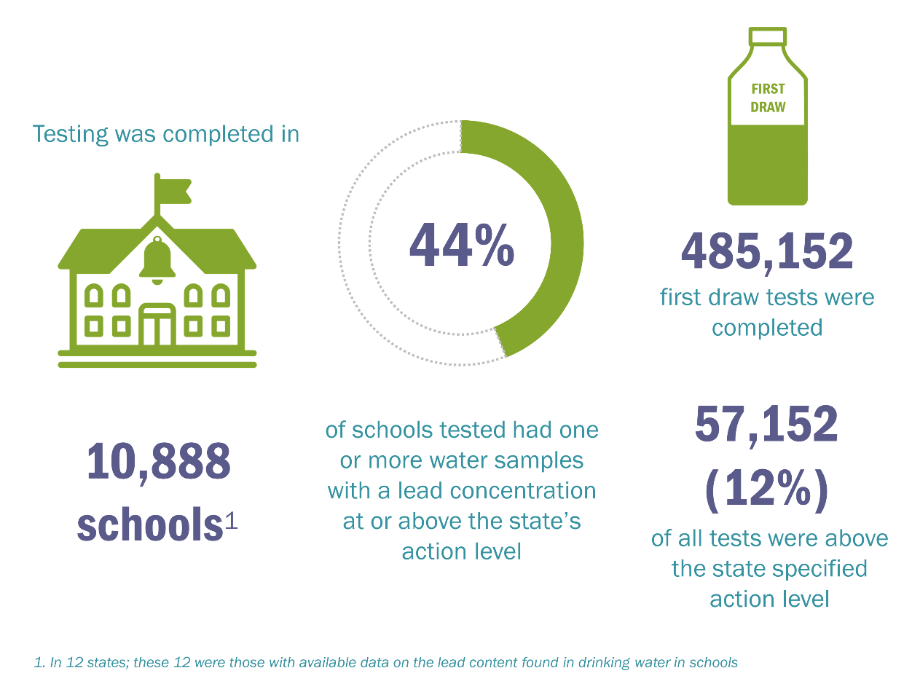A study from the Harvard T. H. Chan School of Public Health conducted in conjunction with researchers from the Nutrition Policy Institute at the University of California describes the features of statewide initiatives in operation between January 1, 2016 and February 28, 2018 in 24 states and the District of Columbia to conduct testing for lead in school drinking water. Researchers found that, despite an uptick in awareness of and attention to the issue of lead in drinking water, many students in the U.S. attend public schools in states where not all taps are tested for lead.
Reports of lead contamination have emerged in schools and communities across the country. Drinking water is important for proper hydration and oral health and can serve as a substitute for sugary drinks in order to help children grow up at a healthy weight. But water must be safe to drink. The Early Adopters report describes the features of statewide initiatives in operation between January 1, 2016 and February 28, 2018 in 24 states and the District of Columbia to conduct testing for lead in school drinking water.
To identify and summarize the features of state policies and programs, researchers conducted online searches using a search engine and by scanning state legislative and department websites and existing resources from public health organizations. Researchers communicated with state government agencies to verify their policy or program and to request relevant documents and up-to-date data on water quality test results for lead.
Key findings of the study include that there is no uniformity in:
- States’ approaches to create and oversee programs to test for elevated lead in school drinking water
- States’ action levels
- States’ protocols to test school drinking water for lead and to share their findings
- States’ recommendations for school responses to testing
- States’ organization and maintenance of water quality data
In 12 states (which were those with available data on the lead content found in drinking water in schools), the research team found that:
- 12% of all water samples tested had a lead concentration at or above the state’s action level
- 44% of schools tested had one or more water samples with a lead concentration at or above the state’s action level
- Schools that collected and tested water from a greater number of taps were also more likely to identify a sample with elevated lead concentrations
- Use of lower action levels by a state program would increase the proportion of schools that would need to take steps to address the content of lead in the drinking water
There are also important implications for policy and practice, including:
- More states would be supported in adopting effective practices to limit lead exposure in school drinking water outlets if standardized practices for tap water sampling and remediation were set
- Up-to-date electronic data management guidance could standardize practices for data collection, database development and reporting which could improve timely identification of elevated lead levels in school tap water and limit exposure to lead
- Relevant federal and state agencies must ensure that all children have easy and appealing access to lead-safe school drinking water to support the promotion of drinking water as a healthy beverage of choice
Some states are newly adopting and modifying policies and programs for testing lead in school drinking water. Over the project period, four (16%) of the 25 states made modifications to their water testing programs. Since March 1, 2018, at least two additional states have adopted a policy or program to test for lead in school drinking water.
However, further research is needed to determine a health-based standard for regulating lead concentration in school drinking water and the optimal approaches for initial assessment and ongoing monitoring of lead content in drinking water in schools in a way that is most protective of children’s health. Such research could also identify remediation strategies that are most effective and cost-effective in reducing lead – and the likelihood of lead – in school drinking water.
Learn more about the Early Adopters project here.
Cradock AL, Poole MK, Vollmer LY, Barrett JL, Flax CN, Hecht CA. State approaches to testing school drinking water for lead in the United States. Boston, MA: Prevention Research Center on Nutrition and Physical Activity at the Harvard T.H. Chan School of Public Health; 2019. Available at https://www.hsph.harvard.edu/prc/projects/school-research/early-adopters.
Address correspondence to Angie Cradock, ScD, MPE at acradock@hsph.harvard.edu
